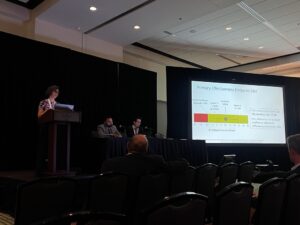
Preliminary results from the prospective, randomised, multicentre Instylla Hydrogel Embolic System (HES; Instylla) trial show the liquid embolic met primary safety and effectiveness endpoints, with a 99% freedom from major adverse event rate at 30 days follow-up, compared to a literature-derived performance goal of 75%.
The results of the trial were presented by Nadine Abi-Jaoudeh (University of California, Irvine, USA) at the Society of Interventional Radiology (SIR) annual scientific meeting (29 March–2 April, Nashville, USA) during a late-breaking abstract session.
Described as the “first” randomised controlled pivotal study of a liquid embolic for treatment of hypervascular tumours, Abi-Jaoudeh outlined that the Instylla HES is intended for the occlusion of hypervascular tumours, which was compared with standard of care-transarterial embolization/conventional chemoembolization (TAE/TACE).
Instylla HES is a biocompatible, aqueous, polyethylene glycol liquid embolic provided as two precursors that forms a hydrogel in situ when they mix at the target location. A total of 150 patients presenting with hypervascular tumours were enrolled from 22 centres, 84 enrollees were men and 66 women, with an average age of 65.4 years. Inclusion criteria included subjects with a Eastern Cooperative Oncology Group (ECOG) performance status of between 0–2 (except for metastastic disease where it was 0-1) with at least one target vessel <5mm.
Patients were randomised 2:1 to the Instylla HES treatment or the institutionally-indicated standard of care treatment. Patients underwent clinical and imaging follow-up at 30 and 90 days, with an additional clinical follow-up at 180 days post procedure. The majority of patients (44.7%) included in the trial presented with primary liver hepatocellular carcinoma (HCC), liver metastases (18%), benign liver tumours (6.7%), bone tumours (6%), and renal tumours (24.7%).
Addressing SIR 2025 delegates, Abi-Jaoudeh defined their primary safety endpoint as freedom from major adverse events which were “definitely or probably attributable” to the device and/or procedure and Grade ≥3 events per the 2017 SIR guidelines for events of death, non-target embolization, unintended target tissue ischaemia, pulmonary embolism, vascular injury requiring intervention, renal or hepatic failure, abscess in target organ/tissue, or toxic/allergic reaction to HES. The primary effectiveness endpoint was the delivery of the embolic agent to the index tumour feeding vessel with stasis of flow assessed by an independent imaging core laboratory.
Abi-Jaoudeh reported that their preliminary results showed a 99% freedom from major adverse event rate, with a single event attributed to the procedure and not the embolic. Their analysis for technical success was based on 132 vessels in 97 subjects who received HES and 66 vessels in 48 subjects who received standard of care. The speaker detailed that the primary effectiveness endpoint met and surpassed their predefined non-inferiority margin of 10% and technical success was 88.6% and 77.3% for HES and standard of care, respectively.
The Instylla HES data showed a lower numerical incidence of additional embolization procedures beyond the 90-day follow-up, reported at 8.8% for HES and 14.6% for standard of care. Further, no clinically significant non-target embolization was associated with HES, Abi-Jaoudeh outlined.
Speaking to Interventional News about the significance of these findings, Abi-Jaoudeh reiterated that this is the first trial to evaluate liquid embolics in tumours of any kind. “Liquid embolics have largely been used in the neurointerventional space for malformations or aneurysms and more recently in active haemorrhage, but not in hypervascular tumours, so this is very exciting,” she stated.
“Research has shown that ischaemia is really what we’re looking for in these tumours, and [when using embolics] you want deep uniform penetration, ideally into the vasculature down to the capillaries. That’s what’s exciting about this liquid embolic, as it’s made to mould to the vessels and achieve complete embolization,” Abi-Jaoudeh said.
Abi-Jaoudeh continued that combining Instylla HES with other drugs is where she hopes research will go next, as well as evaluating patients treated with the embolic long term. “It’s still early,” she stated, but notes that their team is focused on following up the 66% of patients with malignant tumours in their cohort to gain these long-term data.










